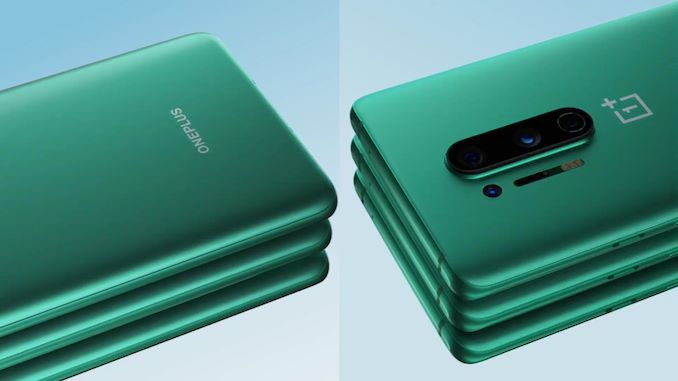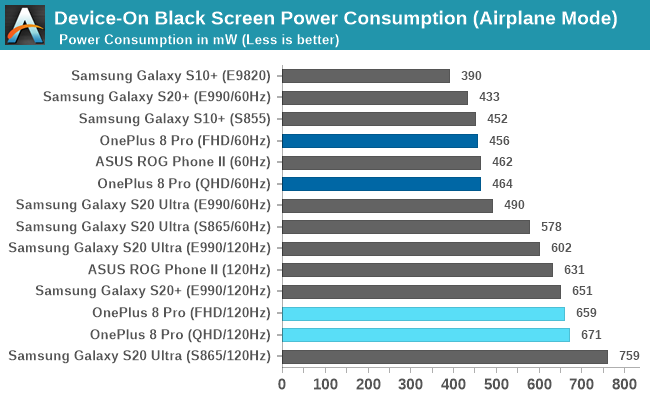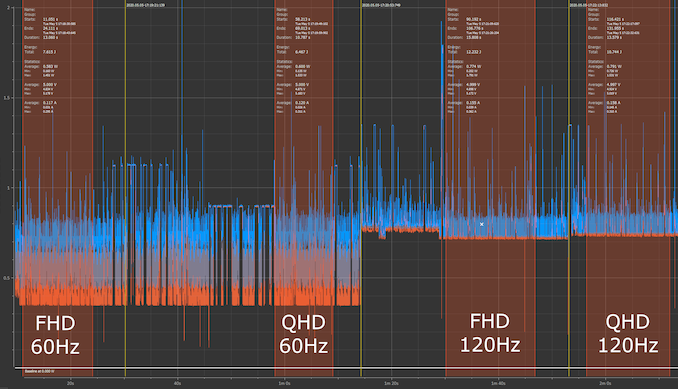120Hz On The OnePlus 8 Pro: QHD+ Resolution But Still Power Hungry
by Andrei Frumusanu on May 5, 2020 1:00 PM EST- Posted in
- Mobile
- Smartphones
- OnePlus
- OnePlus 8 Pro

High refresh rate displays in smartphones are all the rage in 2020, but the new exciting feature is still in its infancy in terms of hardware implementations. Currently there’s still a lot of caveats when using the higher refresh rate, particularly a large impact on the battery life of the phone.
A few weeks ago we covered the characteristic in Samsung’s Galaxy S20 series, noting how it results in a quite large bump in the power consumption of the device, even when seemingly not actually displaying any dynamic content on-screen.
The new OnePlus 8 Pro is another 120Hz flagship device that’s been recently released, and we finally managed to get our hands on a sample. Curiosity got the best of me and the power consumption of the phone at different refresh rates was amongst the first things I tested, particularly because the phone offers the 120Hz refresh rate at a native QHD+ software rendering resolution – something Samsung’s Galaxy S20 series can’t do.
Observing the input power of the phone for a more graphical representation of the different modes, we immediately see that OnePlus’ 120Hz mode incurs a similar power jump to that of the Galaxy S20. The figures here aren’t quite correct as the phone’s power usage when connected to USB is unusually high so don’t pay too much attention to those numbers – just at the differences between the modes.
We can also see that there’s extremely little difference in the base power consumption of the phone between the FHD and QHD modes, both at 60Hz and 120Hz refresh rates. This is actually an important indicator as to narrow down whether the power draw comes from the SoC, or the display panel or DDICs.

Re-measuring the power in a more correct manner, the OnePlus 8 Pro falls in line with other phones of this generation, both at 60 and 120Hz.
We had expected the OnePlus 8 Pro to fare off worse than the Galaxy S20 series, and yes it does draw slightly more power – but not as much as I had initially thought it would. The hardware differences between the phones here relates to their display interfaces, the Galaxy S20 series features a single MIPI lane to the DDIC, a bottleneck that is the reason for why the phone can’t do QHD at 120Hz. The OnePlus 8 Pro on the other hand does feature dual MIPI interfaces to the display panel and thus has the bandwidth necessary for driving the higher refresh rate at the highest resolution.
The fact that the differences between the two phones is only a mere 20-25mW means that the display interfaces have very little to do with the increased power draw. The difference in the base power consumption between FHD and QHD modes is a mere 10mW, so seemingly that also has very little impact on power other than the additional power to actually render higher resolution dynamic content.
It seems that the power consumption here solely is to blame on the DDIC and the display panel itself, both having to work harder to drive the pixel matrix at higher frequencies. It’s a somewhat discouraging confirmation as it means the ecosystem is in dire need for true VRR (variable refresh rate), where the panel doesn’t need to be driven like this during static content.
We’ll be reviewing the OnePlus 8 Pro in more details in a full review in the coming weeks – today’s quick pipeline was just meant to address this burning matter of the 120Hz implementation of the phone. Generally, I expect the 120Hz mode here to have a slightly higher battery impact than what we saw on the S20 series, but nothing to drastically worse.











27 Comments
View All Comments
Nintonito - Tuesday, May 5, 2020 - link
Razer specifically advertised Qualcomm Qsync support though which according to Qualcomm directly (and confirmed by various news outlets) to be analogous to gsync or freesync. What tested have you done that confirms that this is false? Curious because QSync was supposed to be a big feature and dropped off, was it a fake?brucethemoose - Wednesday, May 6, 2020 - link
I'm typing on a Razer Phone 2 now, can I test this without a USB power monitor?The Android FPS debug option and displayhz.com seem to suggest its 120hz all the time.
Nintonito - Wednesday, May 6, 2020 - link
Using the FPS debug option shows variability for me, down to 3fps or so. I have nothing plugged into the device.MrCommunistGen - Tuesday, May 5, 2020 - link
All very interesting information. Based on your findings I also agree that having true VRR would be really useful.I wonder what the gains might look like if they're able to drive refresh rates down to 24/25/30Hz for fullscreen video content. I realize that we're looking at diminishing returns as refreshing the display will become proportionally less of the total display/system draw... but it could be a natural optimization since content consumption is a pretty common usecase.
More realistically I could see them refreshing at double the rate of low frame rate content, so 48Hz/50Hz/60Hz, but content would likely look smoother at a doubled refresh rate than at a non-integer refresh rate, and the lower refresh rate could slightly improve power consumption.
Pipe dreams I'm sure. Incremental gains for significant engineering work.
MrCommunistGen - Tuesday, May 5, 2020 - link
*non-integer multiple of the content's framerateBigos - Tuesday, May 5, 2020 - link
Will you be looking at the non-Pro variant (1080p 90Hz) for comparison?ads295 - Wednesday, May 6, 2020 - link
Yeah I'd be interested in this, too. Much like the debate around what resolution is OK for a given screen size, I have a feeling refresh rates should be subject to the same. Maybe 90Hz and 120Hz have a negligible between them.ads295 - Wednesday, May 6, 2020 - link
Negligible difference* in terms of visual appeal.Hopefully significant difference in terms of power consumption.
Alim345 - Tuesday, May 5, 2020 - link
I think most of "smoothness" feel comes from VRR and lower touch latency. Android probably won't get proper variable refresh support until google and qualcomm get interested in it, since it would require substantial changes to rendering system. Apple is at advantage there.Kishoreshack - Tuesday, May 5, 2020 - link
Bro what is MIPI lane to the DDICAny article to read more about it
If possible try to hyperlink it to the words soo readers will understand it well